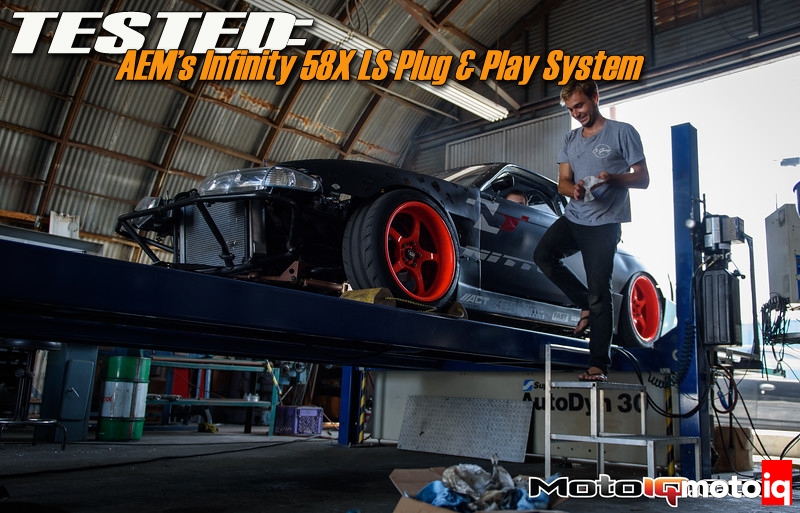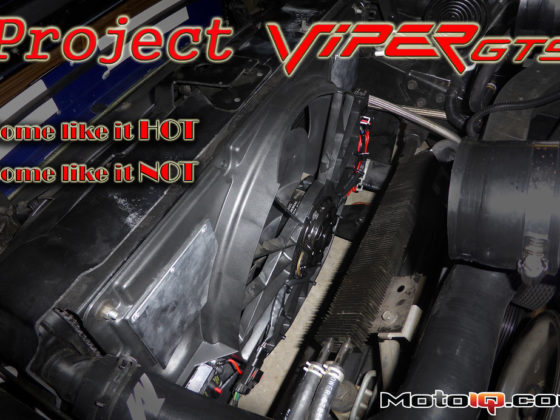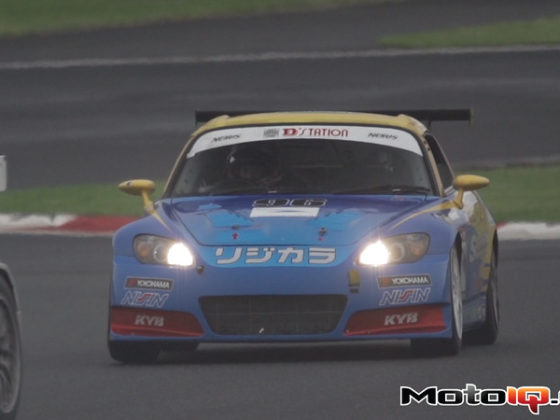
Matt Powers and the AEM Infinity 58X LS Plug and Play System
It's been a long time coming and we have been eagerly anticipating it, but now it's here. AEM Electronics has introduced a plug and play version of the Infinity ECU with a full wire harness to support engine swaps or to make switching to an Infinity ECU on a Chevy LS V8 powered car a piece of cake.
The Chevy LS family of V8 engines is fast becoming the new equivalent of what the Honda B series was for engine swaps. With its compact cylinder heads, due to overhead valves and a 90 degree V angle, the LS is both lightweight and compact and able to put a lot of displacement into a small package. At about 440 lbs fully dressed with all accessories for the aluminum block versions, it is lighter than many turbocharged 4 cylinders.
On pump gas, the LS can offer increased power in a low stress package compared to a high strung turbo engine with comparable or less weight. Its compact exterior dimensions and low overall height are also a plus in getting it to fit into many different chassis with minimal fuss. For instance, in a Nissan S Chassis the LS fits like it was made to go in there and more than a few companies have motor mounts, headers and oil pans to make the swap a drop-in procedure. An LS swapped 240SX is a formidable car. With suspension, brake mods and sticky tires, it can perform right up there with modern expensive super cars.
We set out to evaluate AEM's new plug and play engine management solution with the help of our friend Matt Powers. Matt used to be one of the stars of Formula D, but he now mostly competes overseas and does drift demos for his sponsors stateside. Matt's demo car is powered by a Chevrolet Performance LS3 crate motor. The Demo car is actually the infamous Pirate Ship, Matt's original competition car that he basically grew up with and initially competed as a pro in. Remember the green hella flush poster boy car? Well this was it!
In prepping his car for the grueling all day drift demo at Nitto's Auto Enthusiast Day, Matt had swapped his intake manifold for a FAST LSX and added a mild hydralic roller Comp Cam. Matt was figuring that this would be good for around 40 more WHP over stock. Since he was greatly changing the engine's flow characteristics, now was a good time for a stand alone ECU and Matt chose the AEM Infinity.
 Matt selected the AEM Infinity 8H for his car. The heart of the Infinity is a 200MHz processor that can process at 400 MIPS. It can log 64 GB of data at 1 KHz. The Infinity also has a sealed water and shock resistant enclosure and com ports. This can allow it to be mounted in the engine compartment if desired. The Infinity is multi map capable and has the capacity for tons of data logging. The Infinity ECU is very cost effective and saves both parts and labor costs with its plug and play harness.
Matt selected the AEM Infinity 8H for his car. The heart of the Infinity is a 200MHz processor that can process at 400 MIPS. It can log 64 GB of data at 1 KHz. The Infinity also has a sealed water and shock resistant enclosure and com ports. This can allow it to be mounted in the engine compartment if desired. The Infinity is multi map capable and has the capacity for tons of data logging. The Infinity ECU is very cost effective and saves both parts and labor costs with its plug and play harness.  The coolest thing about this system is the harness. The harness is completely plug and play and clicks directly into the stock GM sensors. Although it's not MIL-Spec, the AEM harness is OEM quality with quality terminations and wire, and shielded wire being used where appropriate. It is also wrapped with an abrasion resistant sheath and has appropriate strain relief. Unlike other GM plug and play EZ wire harnesses the AEM harness has generous protection for its power distribution side with 5 fuses and 7 relays.
The coolest thing about this system is the harness. The harness is completely plug and play and clicks directly into the stock GM sensors. Although it's not MIL-Spec, the AEM harness is OEM quality with quality terminations and wire, and shielded wire being used where appropriate. It is also wrapped with an abrasion resistant sheath and has appropriate strain relief. Unlike other GM plug and play EZ wire harnesses the AEM harness has generous protection for its power distribution side with 5 fuses and 7 relays. The AEM harness has provisions for AEM's latest fast sampling wideband AFR sensor with no need for extension cables. Here we have the additional on board controller and wideband kit Matt added to the his set-up. The Infinity already has a built in controller for one wideband, but Matt wanted the additional sensor in order to get feedback control for both banks of cylinders.
The AEM harness has provisions for AEM's latest fast sampling wideband AFR sensor with no need for extension cables. Here we have the additional on board controller and wideband kit Matt added to the his set-up. The Infinity already has a built in controller for one wideband, but Matt wanted the additional sensor in order to get feedback control for both banks of cylinders. Matt's system included monitoring of the oil pressure and fuel pressure to set up engine safeguards via the Infinity system. If fuel pressure, oil pressure or engine temperatures go beyond pre programmed parameters the ECU will put the engine in a protected mode where full power operation is not possible to both get the driver's attention and greatly reduce the chances of engine damage.
Matt's system included monitoring of the oil pressure and fuel pressure to set up engine safeguards via the Infinity system. If fuel pressure, oil pressure or engine temperatures go beyond pre programmed parameters the ECU will put the engine in a protected mode where full power operation is not possible to both get the driver's attention and greatly reduce the chances of engine damage.




1 comment